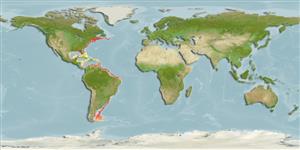>
Clupeiformes (Herrings) >
Engraulidae (Anchovies) > Engraulinae
Etymology: Engraulis: Greek, eggraulis, -eos = anchovy (Ref. 45335).
More on authors: Swain & Meek.
Environment: milieu / climate zone / depth range / distribution range
Ecologia
marino; distribuzione batimetrica 124 - 282 m (Ref. 5951). Tropical; 45°N - 0°, 91°W - 46°W (Ref. 189)
Western Atlantic: Massachusetts south to Florida and the northeastern Gulf of Mexico - at least to about Mississippi sound, but not recorded elsewhere; Venezuelan coast to northern Brazil at 2°19'N.
Size / Peso / Age
Maturity: Lm ? range ? - ? cm
Max length : 15.5 cm TL maschio/sesso non determinato; (Ref. 37032); common length : 8.0 cm TL maschio/sesso non determinato; (Ref. 5217)
Spine dorsali (totale): 0; Raggi dorsali molli (totale): 13-16; Spine anali 0; Raggi anali molli: 13 - 18. Hardly differs from European anchovy (see E. encrasicolus) and can be identified from that description. Differs from Atlantic species of Anchoviella by its much longer pseudobranch (more than eye diameter and reaching onto inner face of operculum); differs from Atlantic species of Anchoa in its short and blunt-tipped maxilla (cf. pointed and reaching onto pre-operculum or beyond) (Ref. 189).
Common in shallow sheltered waters like harbors, etc., forming compact schools. Spawning peak is in July or August. Eggs are ellipsoidal (Ref. 189).
Life cycle and mating behavior
Maturità | Riproduzione | Deposizione | Uova | Fecundity | Larve
Whitehead, P.J.P., G.J. Nelson and T. Wongratana, 1988. FAO Species Catalogue. Vol. 7. Clupeoid fishes of the world (Suborder Clupeoidei). An annotated and illustrated catalogue of the herrings, sardines, pilchards, sprats, shads, anchovies and wolf-herrings. FAO Fish. Synop. 125(7/2):305-579. Rome: FAO. (Ref. 189)
IUCN Red List Status (Ref. 130435)
Threat to humans
Harmless
Human uses
Pesca: scarso interesse commerciale
Informazioni ulteriori
BibliografiaAcquacolturaProfilo di acquacolturaVarietàGeneticaElectrophoresesEreditarietàMalattieElaborazioneNutrientsMass conversion
CollaboratoriImmaginiStamps, Coins Misc.SuoniCiguateraVelocitàModalità di nuotoArea branchialeOtolithsCervelliVista
Strumenti
Special reports
Download XML
Fonti Internet
Estimates based on models
Preferred temperature (Ref.
123201): 4.6 - 20.6, mean 6.6 °C (based on 137 cells).
Phylogenetic diversity index (Ref.
82804): PD
50 = 0.5020 [Uniqueness, from 0.5 = low to 2.0 = high].
Bayesian length-weight: a=0.00457 (0.00213 - 0.00980), b=3.12 (2.95 - 3.29), in cm total length, based on LWR estimates for this Genus-body shape (Ref.
93245).
Trophic level (Ref.
69278): 3.0 ±0.1 se; based on size and trophs of closest relatives
Resilienza (Ref.
120179): Alto, tempo minimo di raddoppiamento della popolazione meno di 15 mesi (Preliminary K or Fecundity.).
Fishing Vulnerability (Ref.
59153): Low vulnerability (10 of 100).
Nutrients (Ref.
124155): Calcium = 364 [152, 917] mg/100g; Iron = 1.51 [0.70, 3.62] mg/100g; Protein = 17.9 [16.6, 19.3] %; Omega3 = 0.607 [0.318, 1.190] g/100g; Selenium = 42.9 [17.5, 109.5] μg/100g; VitaminA = 22.7 [4.7, 103.7] μg/100g; Zinc = 1.71 [1.03, 2.85] mg/100g (wet weight);
